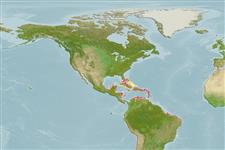Common names from other countries
Classification / Names / Names
Nomes comuns | Sinónimos | Catalog of Fishes (gen., sp.) | ITIS | CoL | WoRMS
Environment: milieu / climate zone / depth range / distribution range
Ecologia
; estuarina; intervalo de profundidade 1 - 2 m (Ref. 86836). Tropical; 25°C - 33°C (Ref. 86836)
Western Central Atlantic.
Length at first maturity / Tamanho / Peso / Idade
Maturity: Lm ? range ? - ? cm Max length : 1.0 cm OT macho/indeterminado; (Ref. 415)
Massive lobate to ramose. Color: dark green externally, lighter internally. Surface smooth with oscular chimneys; 0.5 - 1 cm diameter. The species is compressible but crumbly in consistency (Ref. 415).
Maximum surface diameter: 1 cm (Ref. 415). Depth range from Belize (Ref. 086836). Common on shallow reefs, seagrass beds, and mangroves (Ref. 415).
Life cycle and mating behavior
Maturidade | Reprodução | Desova | Ovos | Fecundidade | Larvas
Members of the class Demospongiae are hermaphroditic. Life cycle: The zygote develops into parenchymella larva (free-swimming) before settling down on a substrate where it grows into a young sponge.
Collin, R., M.C. Díaz, J. Norenburg, R.M. Rocha, J.A. Sánchez, M. Schulze, A. Schwartz and A. Valdés. 2005. (Ref. 415)
Categoria na Lista Vermelha da IUCN (Ref. 130435)
Categoria CITES (Ref. 108899)
Not Evaluated
Not Evaluated
Ameaça para o homem
Harmless
Utilização humana
| FishSource |
Ferramentas
Mais informação
Nomes comunsSinónimosPredadoresReproduçãoMaturidadeDesovaFecundidadeOvosDesenvolvimento dos ovos
Fontes da internet
Estimates based on models
Preferred temperature
(Ref.
115969): 26.3 - 28.4, mean 27.4 (based on 151 cells).
Vulnerabilidade
Low vulnerability (10 of 100).
Categoria de preço
Unknown.
